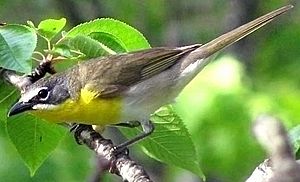Yellow-breasted chat facts for kids
Quick facts for kids Yellow-breasted chat |
|
|---|---|
 |
|
| Conservation status | |
| Scientific classification | |
| Genus: |
Icteria
|
| Species: |
virens
|
 |
|
| Synonyms | |
|
Turdus virens Linnaeus, 1758 |
|
The yellow-breasted chat (Icteria virens) is a large songbird found in North America. It is the only member of its own bird family, called Icteriidae. This bird was once thought to be part of the New World warbler family. However, in 2017, the American Ornithological Society decided it was unique enough to have its own family. Scientists are still studying its exact family tree.
Contents
Where Yellow-Breasted Chats Live
The yellow-breasted chat can be found all across North America. These birds breed, or have their babies, from the southern plains of Canada down to central Mexico. When winter comes, most of them migrate south to Mexico and Central America. Some might stay in warmer coastal areas further north.
Finding Their Home: Habitat
Yellow-breasted chats love places with lots of thick bushes and shrubs. You can often find them in old farmlands or other rural areas. These are places where plants have grown wild and thick.
What Yellow-Breasted Chats Look Like
If yellow-breasted chats were still considered part of the New World warbler family, they would be the biggest warbler species. They can weigh more than twice as much as other warblers! But remember, scientists are still debating if they belong in that group.
Size and Features
These birds are about 17 to 19.1 cm (6.7 to 7.5 in) long. Their wings can spread out to 23 to 27 cm (9.1 to 10.6 in) wide. They usually weigh between 20.2 to 33.8 g (0.71 to 1.19 oz). Their wing is about 7.1 to 8.4 cm (2.8 to 3.3 in). They have a long tail that is 6.9 to 8.6 cm (2.7 to 3.4 in). Their bill is fairly long and strong, measuring 1.3 to 1.6 cm (0.51 to 0.63 in). Their legs, called the tarsus, are about 2.5 to 3.1 cm (0.98 to 1.22 in) long.
Yellow-breasted chats have olive-green feathers on their backs. Their bellies are white, and their throats and chests are a bright yellow. A special feature is the large white ring around each eye. They also have dark, almost black, legs. When you see a yellow-breasted chat, it's hard to mistake it for any other bird!
Yellow-Breasted Chat Life and Habits
The yellow-breasted chat is a shy bird that likes to stay hidden. You often hear its unique song before you see the bird itself. During the breeding season, they live in thick, brushy areas and hedgerows.
Nests and Young Birds
These birds build large, cup-shaped nests. They make them from grasses, leaves, strips of bark, and weed stems. They line the inside with softer materials like fine grasses, thin plant stems, pine needles, and sometimes even animal hair. Nests are always built in thick bushes, usually only about 2.5 m (8.2 ft) above the ground.
Female chats lay three to five creamy-white eggs. These eggs have reddish-brown spots or speckles. The female bird sits on the eggs to keep them warm, and they hatch in 11 to 12 days. Both parents take care of the young birds. The young birds are ready to leave the nest in about 8 to 11 days.
Yellow-breasted chats are good at protecting their nests. They are not often bothered by brown-headed cowbirds, which are birds that try to lay their eggs in other birds' nests. However, chats are not always monogamous, meaning one male and one female stay together. One study found that some baby chats in a nest had a different father than the male who was helping raise them.
What Yellow-Breasted Chats Eat
Yellow-breasted chats eat both plants and insects, making them omnivores. They look for food in dense plants. They mostly eat insects and berries. Some berries they enjoy are blackberries and wild grapes.
They eat insects of different sizes, including grasshoppers, bugs, beetles, weevils, bees, wasps, tent caterpillars, ants, moths, and mayflies. Sometimes, they also eat other invertebrates like spiders. It's unusual for a songbird of its size, but the chat sometimes holds its food with its feet before eating it!
Their Unique Songs
The songs of yellow-breasted chats are very strange and change a lot. They sound like a mix of cackles, clucks, whistles, and hoots. Their calls are harsh chak's. Unlike most warblers, this bird can mimic the calls of other birds.
Because of this, people who are new to birdwatching might sometimes miss seeing chats. They might mistake their song for birds like grey catbirds or brown thrashers. These other birds live in similar places and also like to hide, but they are usually much more common. During the breeding season, chats are easiest to spot. They often sing from open spots and even fly around while making their gurgling songs.
Status of Yellow-Breasted Chats
The number of yellow-breasted chats is going down in eastern North America. This is mainly because of habitat loss. Their homes are being destroyed or changed by deforestation (cutting down forests) and new buildings in cities.
Even though they are less likely to be affected than some other birds, chats can still be victims of brood parasitism. This is when brown-headed cowbirds lay their eggs in chat nests. Cowbirds have spread their range as forests have been broken up over the last century.
However, the yellow-breasted chat still lives in a very large area. Because of this, it is currently considered a species of least concern globally. This means it is not in immediate danger of disappearing.
See also
 In Spanish: Reinita grande para niños
In Spanish: Reinita grande para niños


